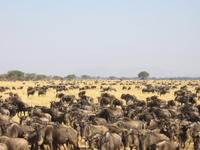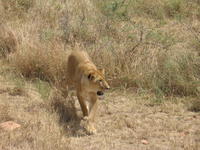Western Serengeti to Fort Portal, Uganda
August 3, 2005
 On July 25 we traveled from Ndutu to the Western Serengeti, to a tented campsite along the Grumeti River about 40 km east of Lake Victoria. The trip was via Seronera in the central Serengeti, where we waited patiently for a reclining cheetah to take a Thomson's gazelle, but the cheetah proved more patient than us and the Tommy lived to another day (we hope). Near Grumeti we met the wildebeest migration - thousands upon thousands upon thousands of them, with perhaps 1 zebra for every 10 beests. Wildebeest low like cattle, zebras honk like donkeys, as their Swahili name punda milia, donkey with stripes, would suggest. A curious kind of music, day and night. Our camp was under 100 yards from the mostly dried up river.
On July 25 we traveled from Ndutu to the Western Serengeti, to a tented campsite along the Grumeti River about 40 km east of Lake Victoria. The trip was via Seronera in the central Serengeti, where we waited patiently for a reclining cheetah to take a Thomson's gazelle, but the cheetah proved more patient than us and the Tommy lived to another day (we hope). Near Grumeti we met the wildebeest migration - thousands upon thousands upon thousands of them, with perhaps 1 zebra for every 10 beests. Wildebeest low like cattle, zebras honk like donkeys, as their Swahili name punda milia, donkey with stripes, would suggest. A curious kind of music, day and night. Our camp was under 100 yards from the mostly dried up river.Nighttimes at Grumeti brought out the lions. The first of our three nights, one nearby male, about 200 yards away - we saw him mate earlier with a lioness - roared out his territorial rights every 15 minutes or so. The second night two male lions of that pride roared from a somewhat closer distance. Both nights the hippos came out late to browse the grassy banks emitting their own striking song, a resounding whoop! followed by a laughing haw haw haw haw. The third night three male lions did tandem roaring about once every 5 minutes all night long, from about 50 yards away. Their roars are enormous, starting with a repeated rolling blast and ending with a series of almost coughs, all loud and riveting nearly beyond imagining. Something primal keeps a human wide awake during this - or an equally primal knowledge that they're only addressing other lions, and food is everywhere nearby, allows a human to sleep like, well, a baby. Depends on the human.
 Meanwhile, our guide Peter Jones took us on numerous game drives. We saw several kills that lions had carried out minutes or hours before. Always in the truck, one gets to within as little as 10 to 15 feet from a 300 pound lioness with blood on her face or within 50 feet of a 450 pound male lion. Things are touchier when kills are involved. At one kill we saw over 60 vultures lined up to get their portions of a zebra that four lionesses had killed, among them a 3-legged lioness who had the first take at the carcass. Life and death are everywhere apparent. The ground is stewn with bones and skulls and fairly frequent full skeletons. There are hoofprints on every square foot (did I say that already?) and life in every conceivable form crawling, sliding, swimming (huge crocodiles in the river pools), climbing, flying, rooting, diving. And death within inches everywhere around.
Meanwhile, our guide Peter Jones took us on numerous game drives. We saw several kills that lions had carried out minutes or hours before. Always in the truck, one gets to within as little as 10 to 15 feet from a 300 pound lioness with blood on her face or within 50 feet of a 450 pound male lion. Things are touchier when kills are involved. At one kill we saw over 60 vultures lined up to get their portions of a zebra that four lionesses had killed, among them a 3-legged lioness who had the first take at the carcass. Life and death are everywhere apparent. The ground is stewn with bones and skulls and fairly frequent full skeletons. There are hoofprints on every square foot (did I say that already?) and life in every conceivable form crawling, sliding, swimming (huge crocodiles in the river pools), climbing, flying, rooting, diving. And death within inches everywhere around.Peter Jones ran a spectacular camp with fine dining every night complete with fresh greens, wines, and fresh-made everything. Hendrick our chef uses a propane range and an oven made from an overturned tub on acacia logs to make extraordinary meals. We'll post photos later. It's all quite unbelievable.
 On July 29 we drove from the Serengeti to Mwanza city on Lake Victoria. There we flew in a chartered turbo-charged Cessna 206 (cool little plane!) along the shores of Lake Victoria to Entebbe airport in Uganda in order to clear immigration, and from Entebbe to Ishasha in far southwestern Uganda, where we landed on the airstrip in QEII National Park. (At Entebbe we walked on tarmac right by the helicopter that crashed a day or two later in Sudan, killing the Sudanese senior vice president.) Dennis Maboya was our most excellent driver for 5 days after that, to Bwindi and then Fort Portal.
On July 29 we drove from the Serengeti to Mwanza city on Lake Victoria. There we flew in a chartered turbo-charged Cessna 206 (cool little plane!) along the shores of Lake Victoria to Entebbe airport in Uganda in order to clear immigration, and from Entebbe to Ishasha in far southwestern Uganda, where we landed on the airstrip in QEII National Park. (At Entebbe we walked on tarmac right by the helicopter that crashed a day or two later in Sudan, killing the Sudanese senior vice president.) Dennis Maboya was our most excellent driver for 5 days after that, to Bwindi and then Fort Portal. Bwindi. It's under a mile from the Congo, at 4,000 to 8,000 feet. It means a dark and potentially murderous place. The full name is Bwindi Impenetrable Forest National Park. About 300 of the last surviving 700 or so mountain gorillas live here. We trekked up on Saturday and Sunday to see them. The first trek was highly strenuous, in deep jungle just like the name says. Armed guards and trackers led the party of about 12 people. After anywhere from 1 to 3 hours you come face to face with the creatures. Indescribable. You must see it yourself to absorb it fully. You are 10 to 20 feet from a 400 pound wild gorilla, the male silverback, who could care less and who carries on eating with his females and children around him in the dense vegetation. You can photo, but no flash bulbs. Speak quietly, move quietly. The gorillas, "only" 7 million years removed from us evolutionarily, are strikingly human and extraordinarily appealing, from playing children to apparently daydreaming adults.
Bwindi. It's under a mile from the Congo, at 4,000 to 8,000 feet. It means a dark and potentially murderous place. The full name is Bwindi Impenetrable Forest National Park. About 300 of the last surviving 700 or so mountain gorillas live here. We trekked up on Saturday and Sunday to see them. The first trek was highly strenuous, in deep jungle just like the name says. Armed guards and trackers led the party of about 12 people. After anywhere from 1 to 3 hours you come face to face with the creatures. Indescribable. You must see it yourself to absorb it fully. You are 10 to 20 feet from a 400 pound wild gorilla, the male silverback, who could care less and who carries on eating with his females and children around him in the dense vegetation. You can photo, but no flash bulbs. Speak quietly, move quietly. The gorillas, "only" 7 million years removed from us evolutionarily, are strikingly human and extraordinarily appealing, from playing children to apparently daydreaming adults.On Monday we drove to Kasiisi School near Fort Portal, Uganda. We stood astride the equator for a few minutes - of course - having seen lions lying in trees along the road on the drive. In literal terms we went from mid-winter in the sourthern hemisphere to mid-summer in the northern hemisphere. Yet everywhere we go the climate is brilliant, as the British say: warm and maybe a touch humid during the day, cool and brisk and fresh at night. The elevation remains about 5000 feet and we are in the dry season.
More next time on Kasiisi primary school and its environs, which are yet another revelation. The kids left for Kampala and Boston this morning, and we're off to Kibale Forest later today.

0 Comments:
Post a Comment
<< Home